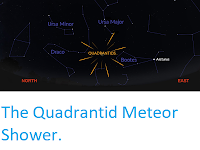Witnesses in Yunnan Province reported seeing a bright fireball meteor close to the city of Xishuangbanna in the southwest of the province, at about 9.40 pm local time on Friday 1 June 2018. A fireball
is defined
as a meteor
(shooting star) brighter than the
planet Venus. These are typically caused by pieces of rock burning up in
the atmosphere, but can be the result of man-made space-junk burning up
on re-entry. Following the event villagers in Menghai County began reporting meteorite falls, with about 200 such rocks found so far, the largest being about 150 g. At least two of the meteorites caused damage to buildings, and several have been sold online, while local authorities attempt to collect them for scientific research.
Fireball over Yunnan Province on 1 June 2018. APTN.
Objects
of this size probably enter the Earth's atmosphere several times a
year, though unless they do so over populated areas they are unlikely to
be noticed. They are officially described as fireballs if they produce a
light brighter than the planet Venus. The brightness of a meteor is caused by friction with
the Earth's atmosphere, which is typically far greater than that caused
by simple falling, due to the initial trajectory of the object. Such
objects typically eventually explode in an airburst called by the
friction, causing them to vanish as an luminous object. However this is
not the end of the story as such explosions result in the production of a
number of smaller objects, which fall to the ground under the influence
of gravity (which does not cause the luminescence associated with
friction-induced heating).
Fragment of meteorite recovered in Yunnan Province following the 1 June 2018 fireball. Yunnan.cn.
These 'dark objects' do not continue along the path
of the original bolide, but neither do they fall directly to the ground,
but rather follow a course determined by the atmospheric currents
(winds) through which the objects pass. Scientists are able to calculate potential trajectories for hypothetical dark
objects derived from meteors using data from weather monitoring services.
See also...
Follow Sciency Thoughts on Facebook.








